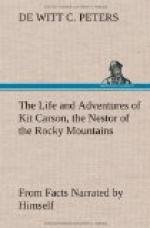It may possibly be asked whether or no a man, who has simply lost his scalp, can recover. In reply we can safely say that without any other wound, and under favorable circumstances, with good care the sufferer stands a chance of being restored to health. There was a man who formerly was living and working at his trade as a blacksmith in Santa Fe, who, in a fight with the Camanches while crossing the plains, was wounded by a lance and then scalped. After a long period of suffering this person entirely recovered, although the cicatrix of the wound was ever afterwards a source of annoyance to him, compelling him continually to wear a skull-cap made of oiled silk. The size of the scalp, as usually taken off by the Indians, varies. Sometimes they remove only the back covering of the head. At other times they cut off the whole, running down even with the margin of the ear. When a man has died in a manner which the Indians style as “brave”—that is, desperately fighting for his life, and never for once showing fear, they take two scalps, one from either side of the head. The object of this is, to have scalp dances for each, as they consider such a man as deserving the fate of two ordinary men. These scalps are often stretched, dried, decorated and frequently kept for years as trophies. The more scalps a warrior takes, the greater favorite he becomes with his tribe; and finally, having obtained a given number, he is considered eligible to fill the office of War Chief, provided he has other qualifications, such as the power of quickly conceiving the right plan on which to act in case of emergency. When a party of Indians in the Rocky Mountains have been on a war trail, met the enemy and vanquished them, they appoint a brave who is honored as being the scalp-bearer. This warrior carries a long pole, to which, at suitable distances from each other, the scalps are attached. When the party returns to, and enters their own village, this brave is the observed of all observers. Eagerly, by the old men, women, and children, these bloody trophies are counted, for each of them offers an occasion for rejoicing, to be at separate intervals of time. They are, then, each synonymous with the phrase, a fete day, and the scalp-bearer is looked




